Synthesis Process
Mappings
To begin our synthesis process, we each generated sticky notes based on our interviews, the baseline study, comparative analysis, and literature review. We ended up with over 120 sticky notes.
For our first mapping technique, we used affinity grouping. As a team, we sorted the post-its into different categories. We sought patterns and weren’t afraid to remix and reorganize our groupings. We were surprised to realize that many post-its were about comfort and discomfort. This suggested to us that decreasing discomfort in compliment giving and receiving would be an important part of our intervention. Discomfort was typically rooted in worrying about creating awkwardness by giving a compliment or being in the spotlight when receiving a compliment. This made us think about how we could design a spotlight-free, awkwardness-free place for compliments to be given and received. We also ended up with a grouping about relationships — people form compliment cycles with their friends, and often use compliments to strengthen relationships. This was an important insight about the importance of close ties in compliment giving; a compliment from a stranger is completely different from a compliment from a friend. This suggested to us that our intervention should be focused on a user’s network of friends.
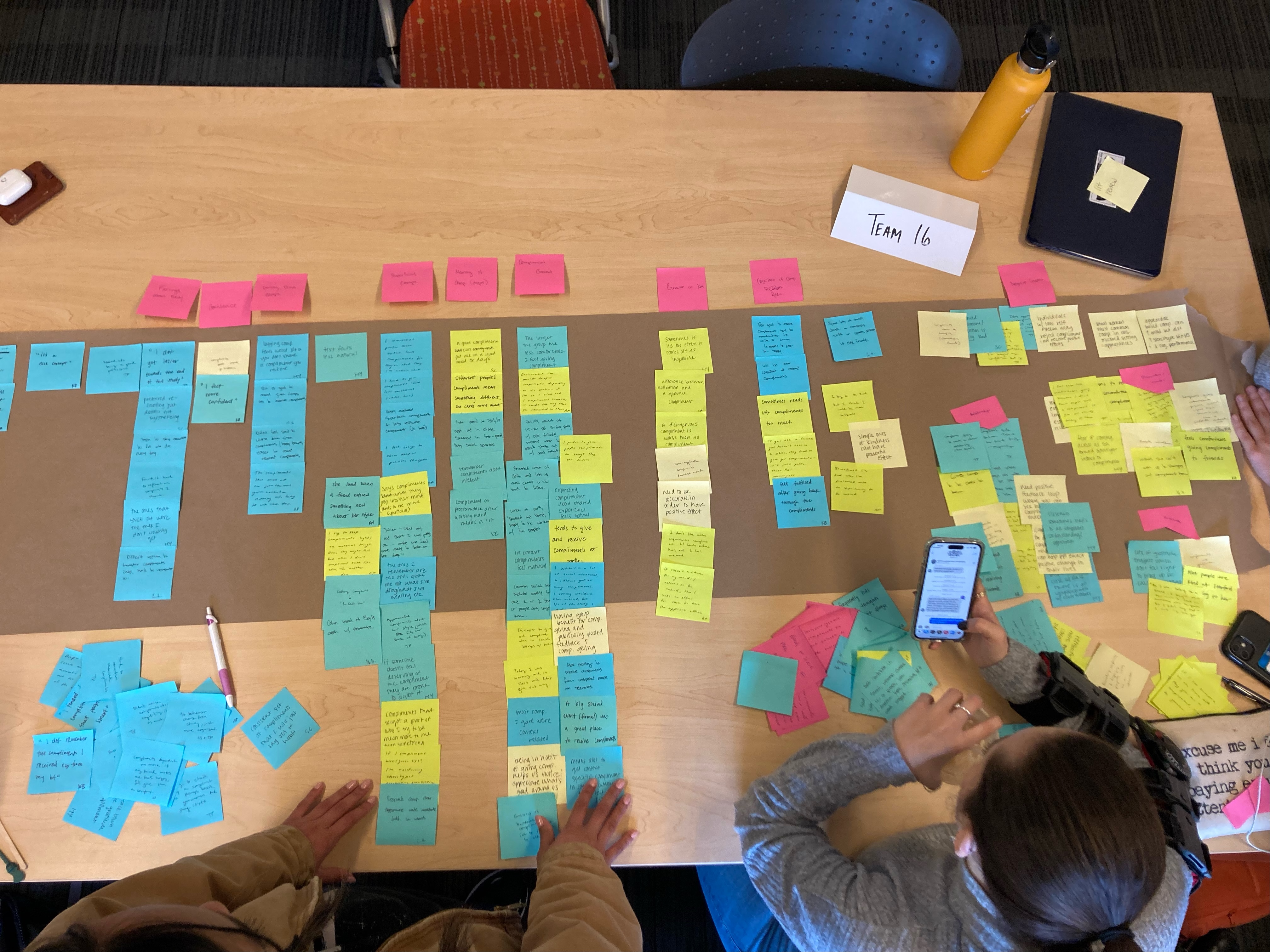
Next, we reorganized our affinity groups by frequency. The most dominant category by far was compliment context. We saw a lot of insights about when and where people felt it was the right context to give compliments. Some felt uncomfortable receiving compliments in public spaces. Many noted that they were more likely to give compliments in more intimate social situations. Others talked about how classes and work meetings weren’t appropriate places for compliments. We continued to think about how we might create a safe space for compliments to flow. From this, we gleaned that many social contexts are not conducive to compliment giving.
The next largest category was superficial compliments. The most common compliments we heard about were about physical appearance, like hair and clothing. We began to think about how we might increase deeper compliments between people, which seemed to create more fulfillment for participants in our study. The deep compliments post-it category was notably smaller.
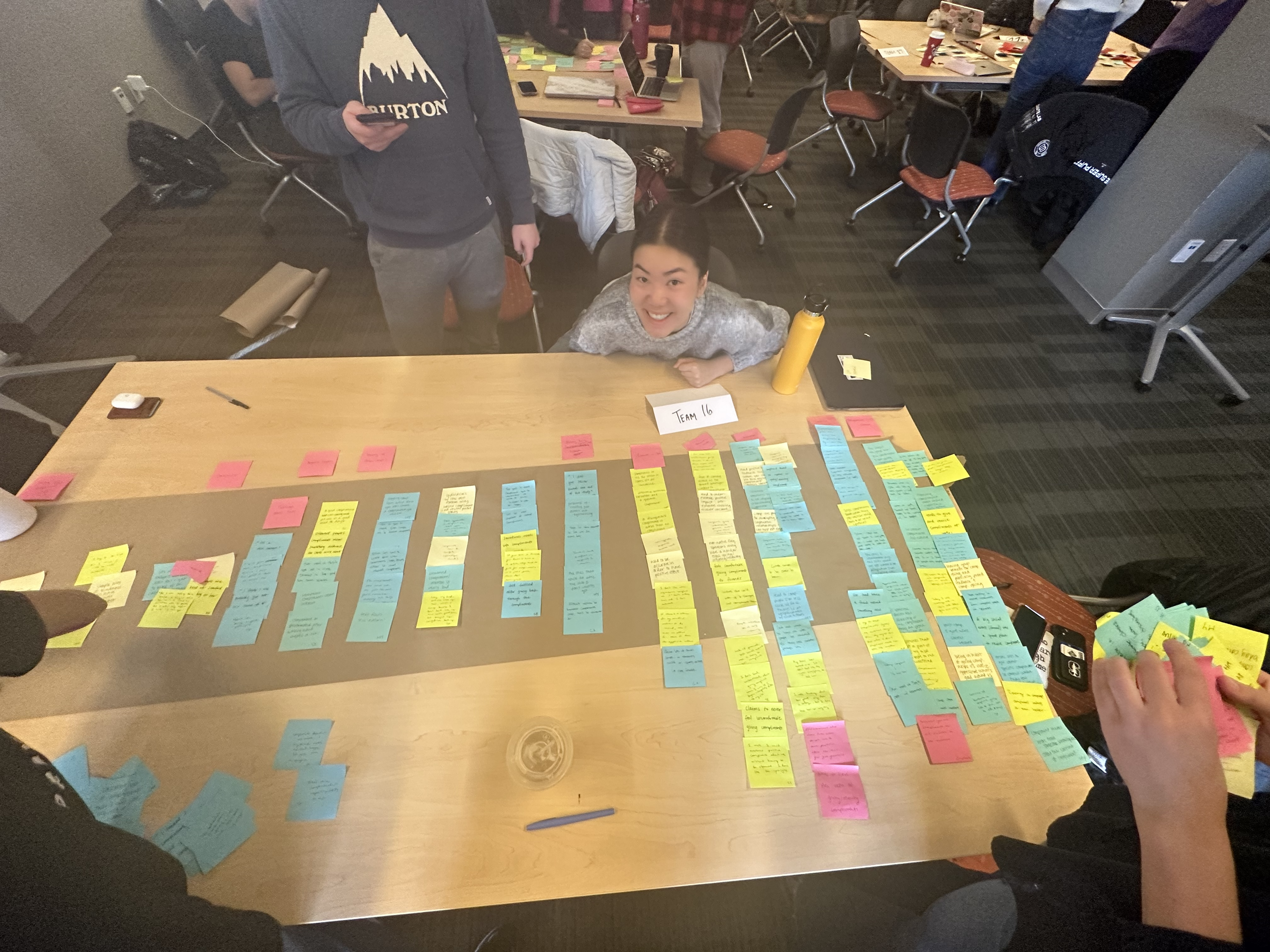
Based on the insights from our frequency mapping, which taught us that social context and compliment superficiality were important features for us to learn more about, we constructed a 2×2 matrix with the y-axis [Superficial → Deep], and x-axis [Close → Stranger] (referring to the intimacy of the social situation). We noticed that the vast majority of sticky notes were clustered in the superficial and close zone. The next biggest category was deep and close. We decided to focus on close friend compliments rather than compliments to and from strangers, since the opportunity seemed bigger. We decided to focus on both superficial and deep compliments since both seem like viable spaces, but with a particular emphasis on deep compliments which may be harder to deliver in person. In thinking about how to encourage deeper compliments, we wondered if sending users prompts throughout their day might encourage them to generate more meaningful positive thoughts (rather than the lower activation, superficial compliments that were most common).
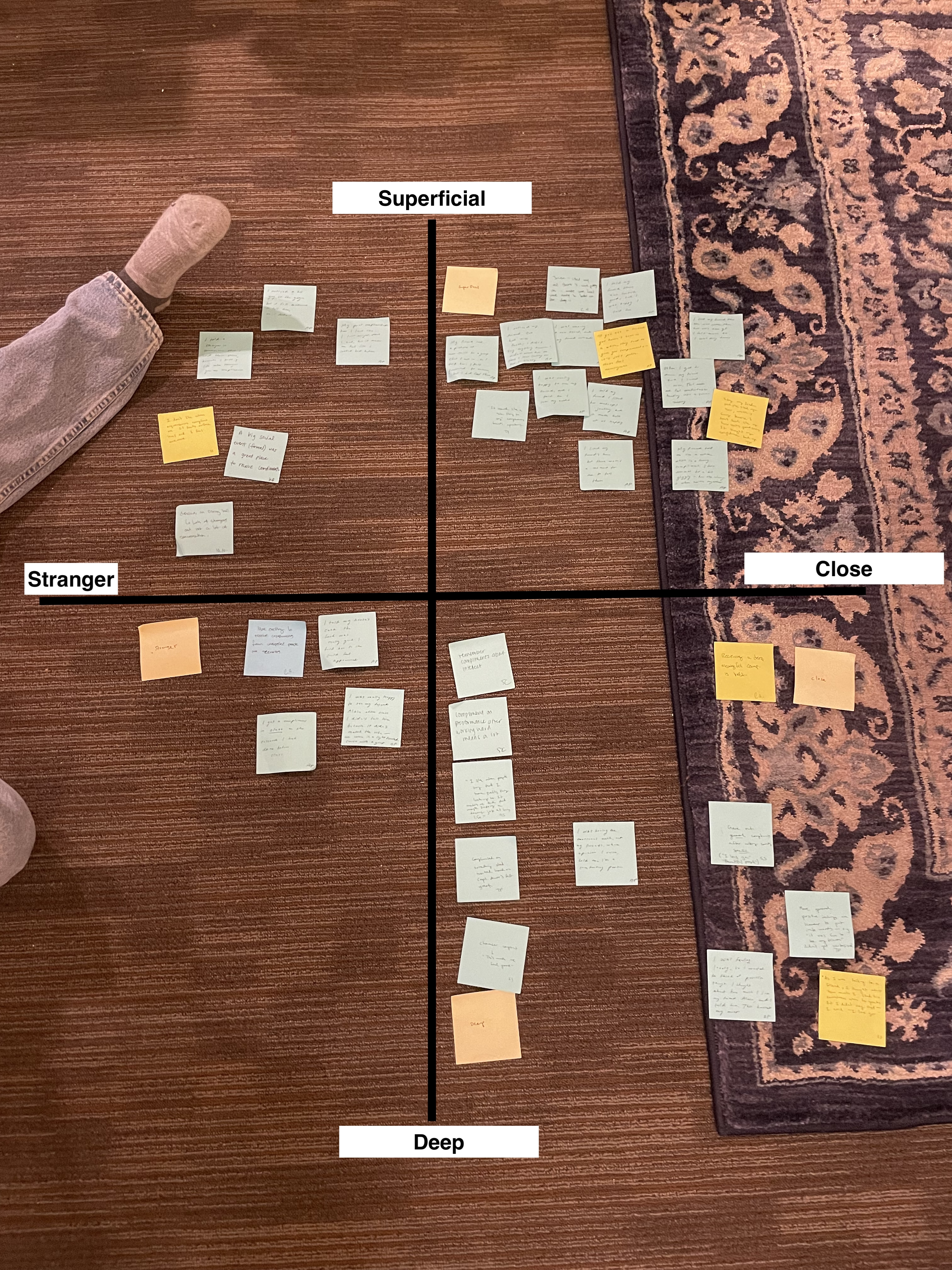
Models
Connection Circle
We created a connection circle to understand what motivates or demotivates giving compliments. In the connection circle the positive edges are marked in green and the negative edges are marked in red. Additionally, gray lines connect nodes which have a causal relationship, but whether it is positive or negative depends on the context. The connection circle tells us that if a deeper compliment is given, the recipient is more likely to reciprocate than if a superficial compliment is given.
From analyzing the connection circle from our baseline study analysis and synthesis, a second simplified connection circle was created to highlight the relationship between giving and receiving compliments, and the context behind the compliment. From this second, smaller connection circle we see that big social events lead to giving superficial compliments which leads to receiving superficial compliments in response. On the other hand, small and intimate interactions lead to giving deeper compliments which prompts receiving deeper compliments in turn. In most cases, superficial compliments lead to superficial compliments, and deeper compliments lead to deeper compliments.
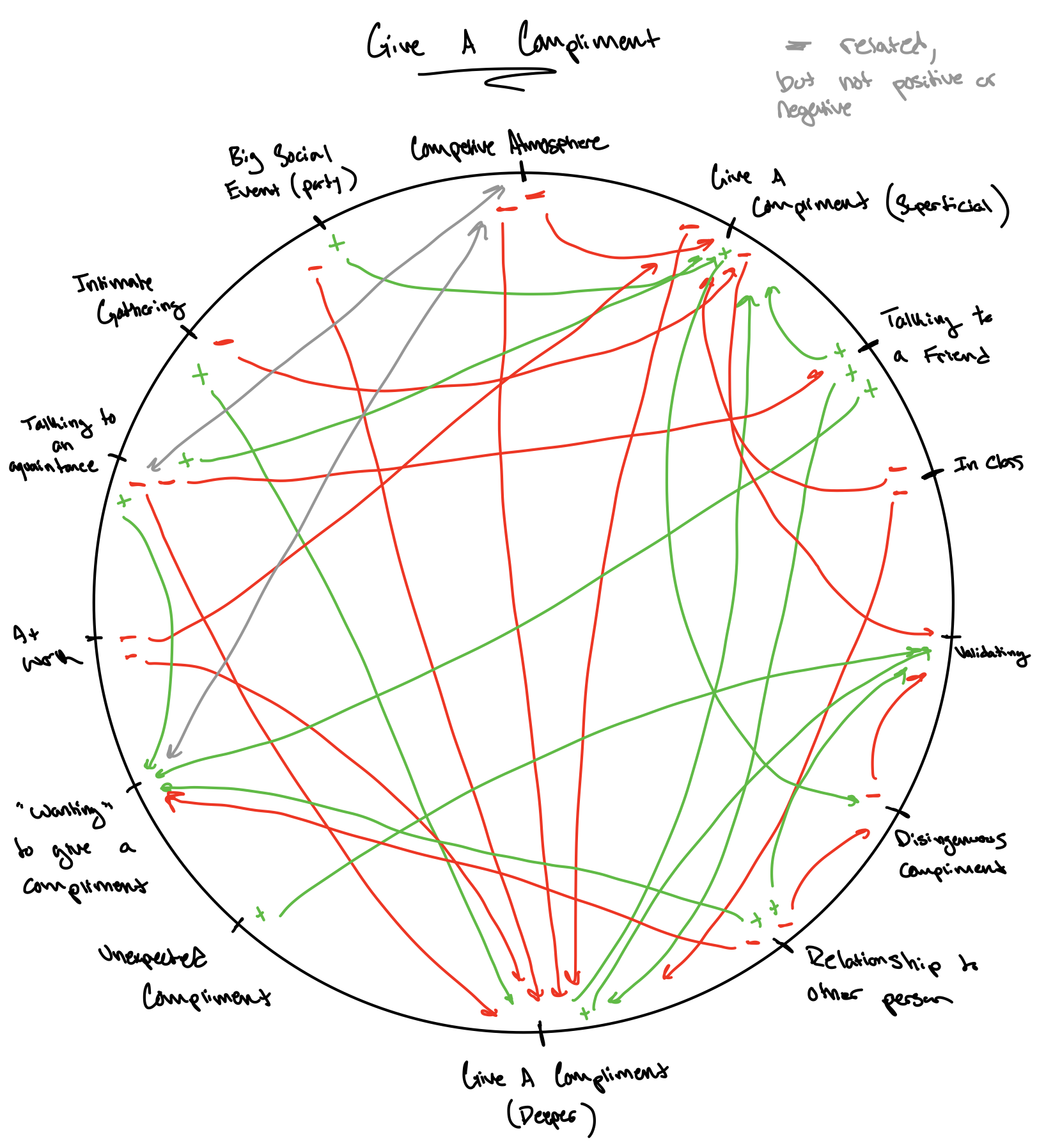
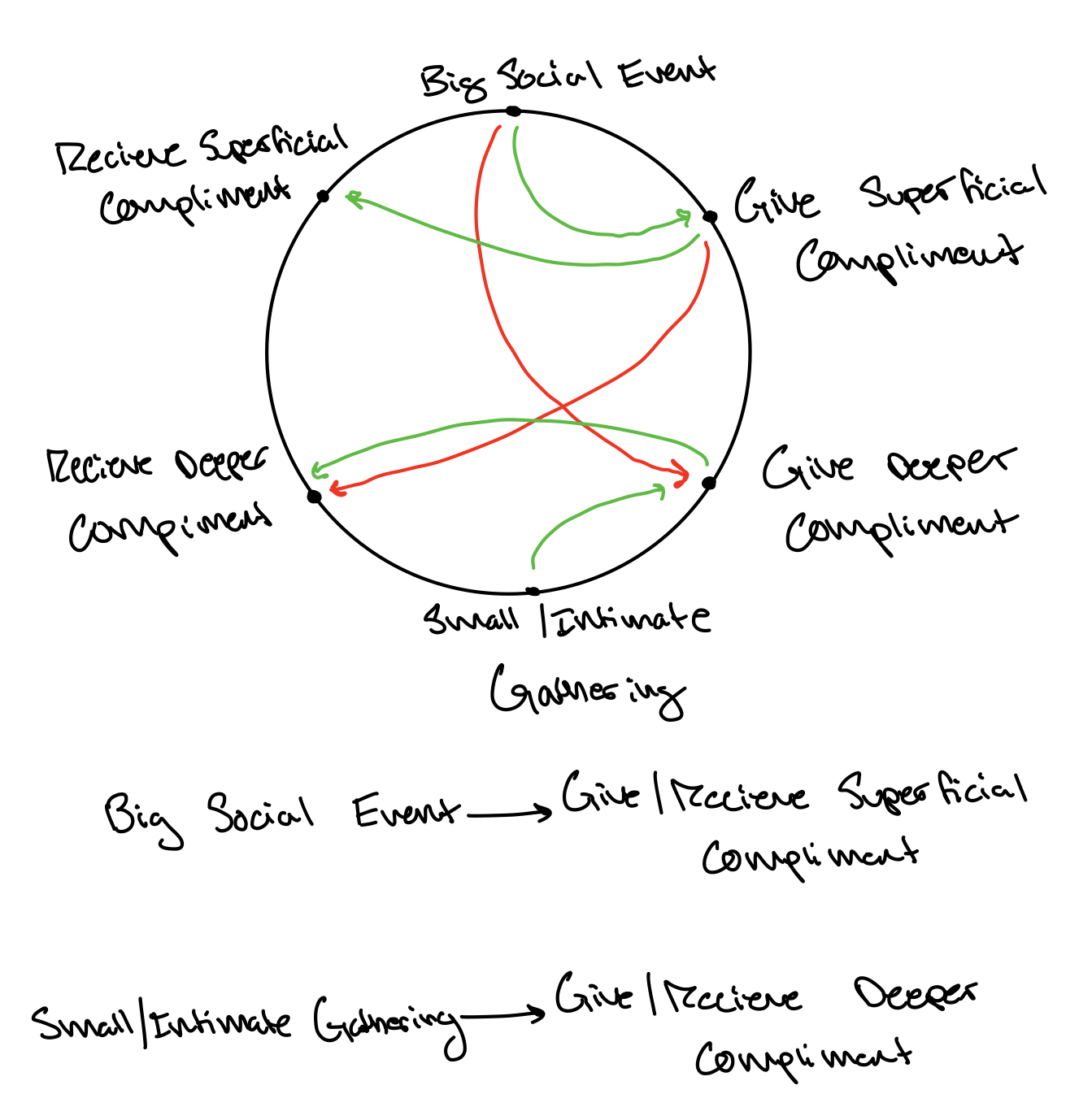
Fishtail Diagram
The fishbone diagram helped tease out reasons for not giving a compliment. The environment and timing of a situation had the largest bearing on whether or not a compliment was given. The materials tended to be correlated to how a compliment would be delivered, but the ultimate reason for not giving a compliment was the context. Like in the connection circle, environmental factors such as being in class, being at work, being with strangers, and being with acquaintances caused a compliment to not be given. Possible interventions to overcome the obstacle of context might look at alternative ways to deliver compliments which aren’t anchored in the moment the compliment originates from; if a positive thought provokes a compliment in an inappropriate time, might there be a way to deliver this compliment through a more appropriate medium, or at a more appropriate time?
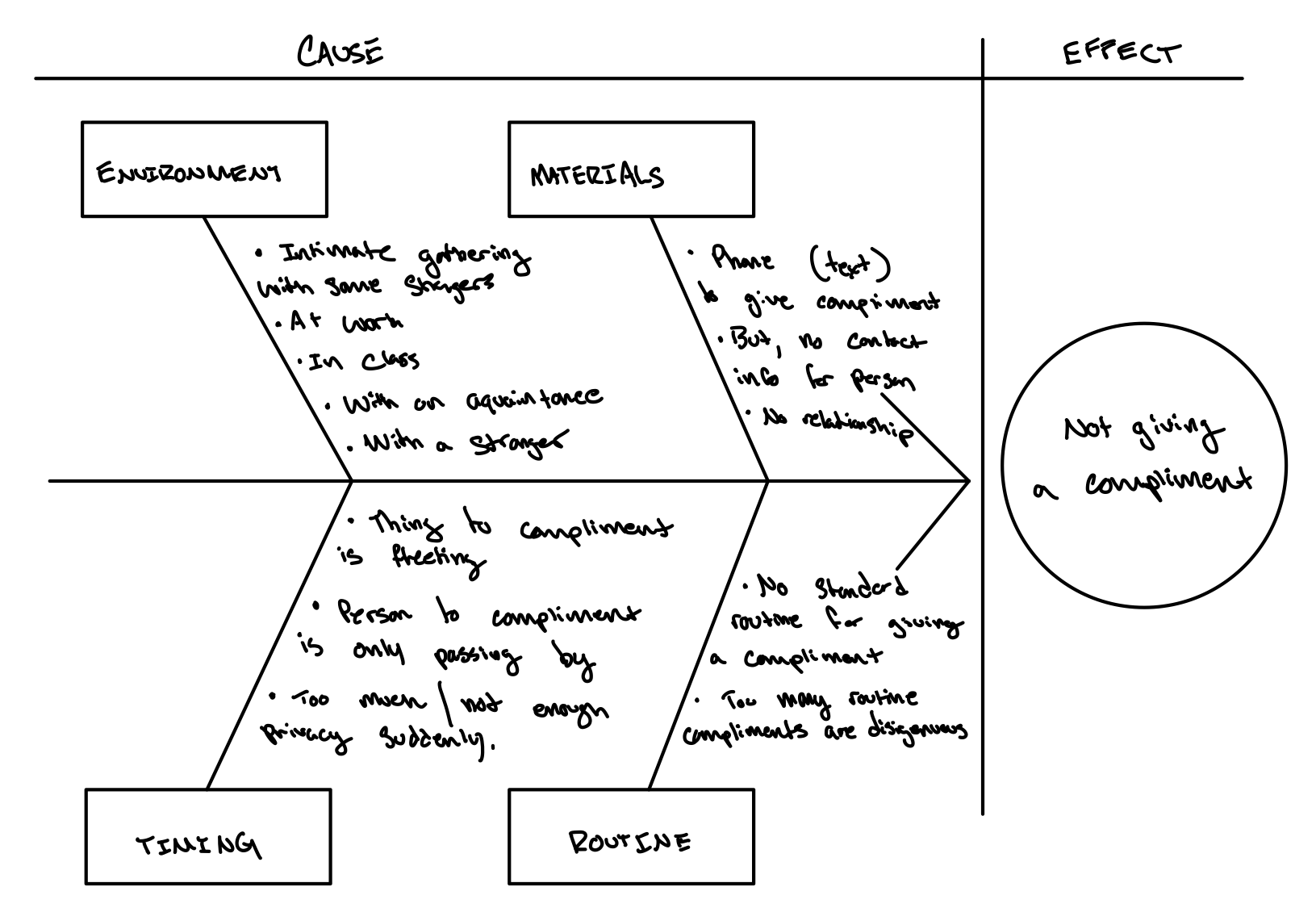
Proto-Personas
Grateful Grace
Grateful Grace is a very outgoing and insightful friend. She loves to socialize and is constantly hanging out with friends and meeting new people. She finds herself giving compliments frequently but tends to share superficial compliments as opposed to more serious ones because it can be awkward to give deep compliments in lighthearted situations. She is conscious about not ruining the mood and saves many of her meaningful compliments for one-on-one interactions or special events (e.g., writing it in a birthday card). She wishes that there was a space to give more thoughtful compliments in a natural and relaxed way.
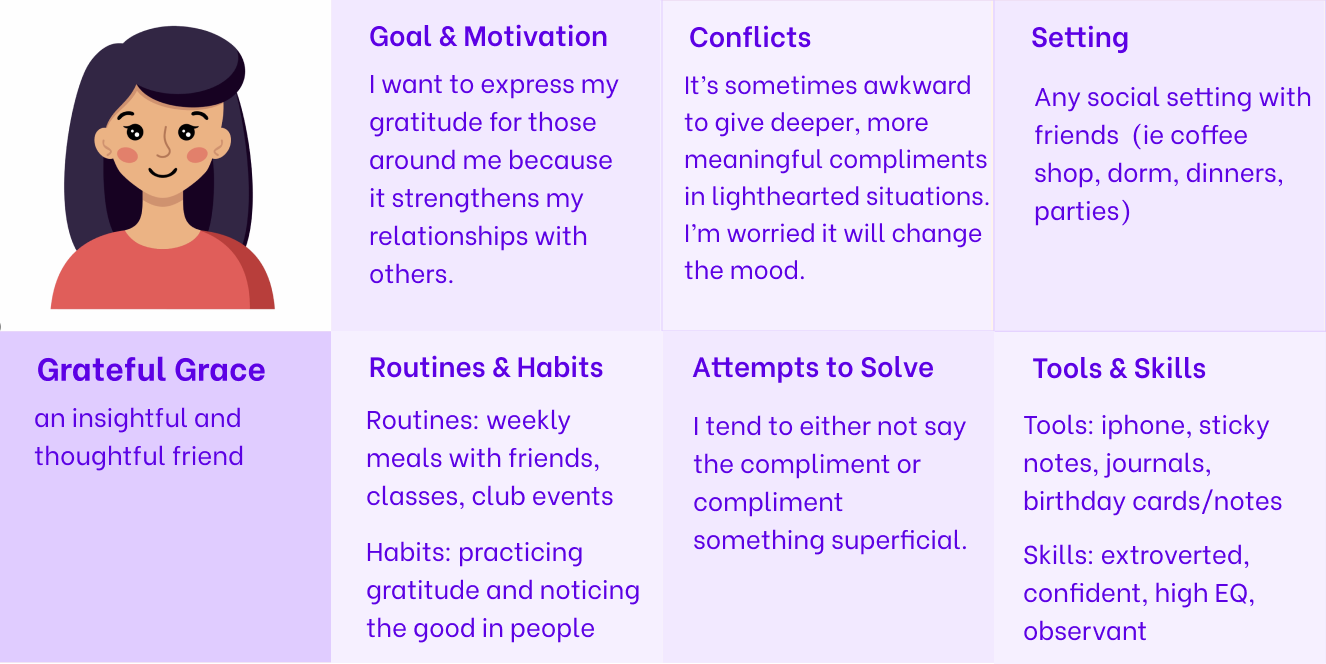
Nervous Nick
Nervous Nick is an observant yet introverted and reserved friend. He wants to make sure that his friends know how much he appreciates them, but is very conscious of not making people uncomfortable in public. He has many positive thoughts but tends to not always share in the moment because he is worried that his friends may not receive them well. He also doesn’t like receiving compliments in front of others because he feels that his reactions are being observed and it makes him nervous. He wishes that there was a platform to give and receive compliments directly to people that’s not in public.
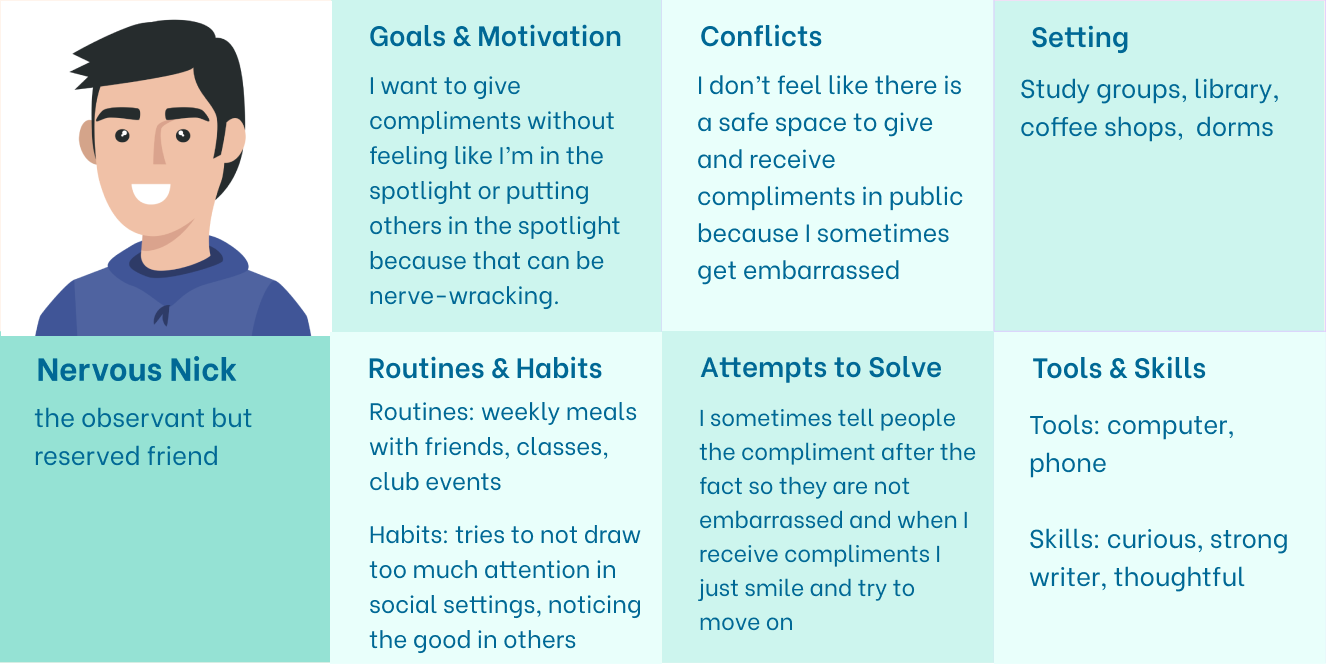
Journey Maps
Once we condensed our proto-personas to Grateful Grace and Nervous Nick, we created two journey maps to identify potential intervention points throughout each persona’s day. We decided to track what the person was thinking, feeling, doing, and saying, as well as their general mood and the closeness of who they are surrounded by (stranger, acquaintance, friend, close friend).
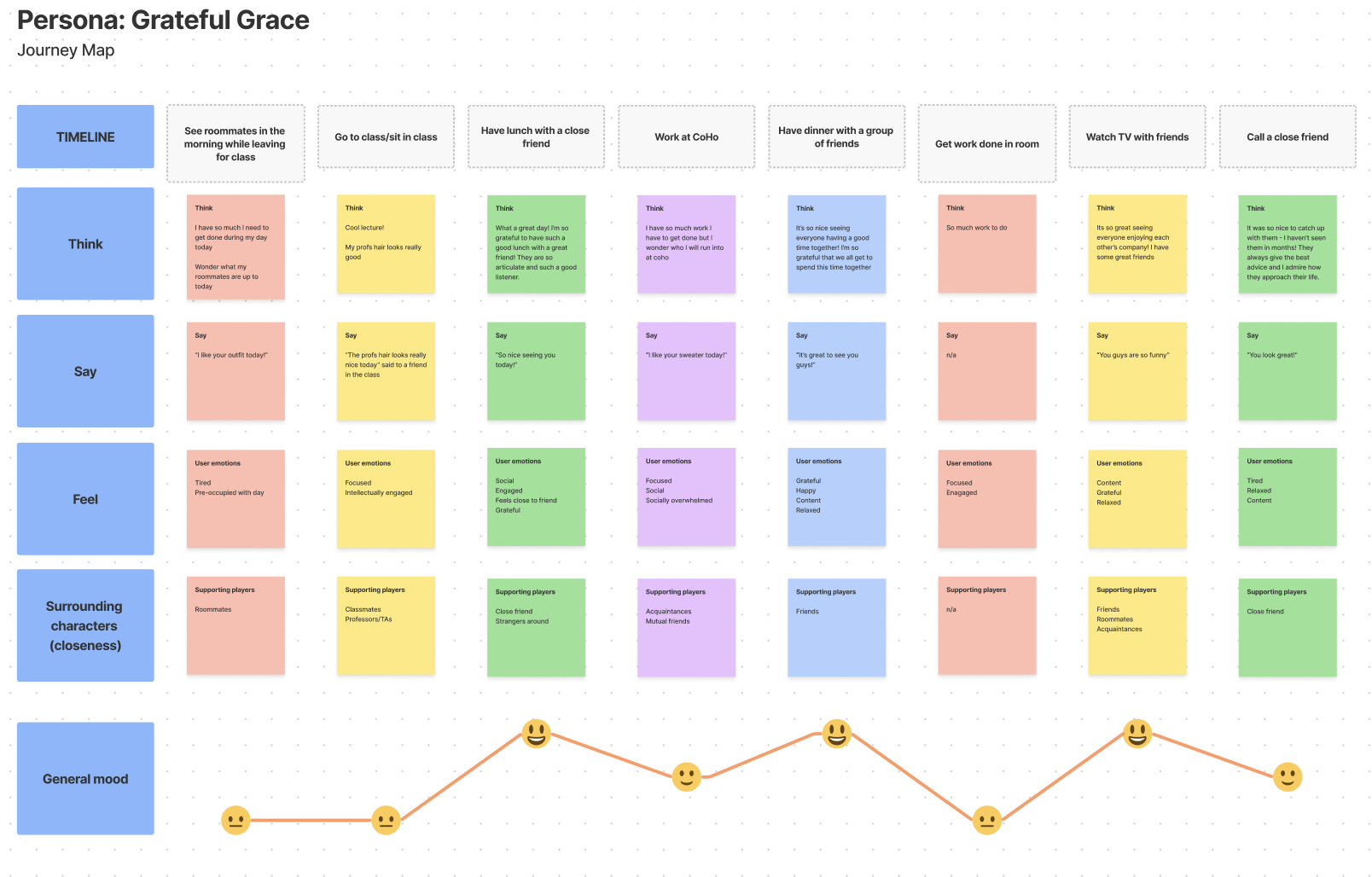
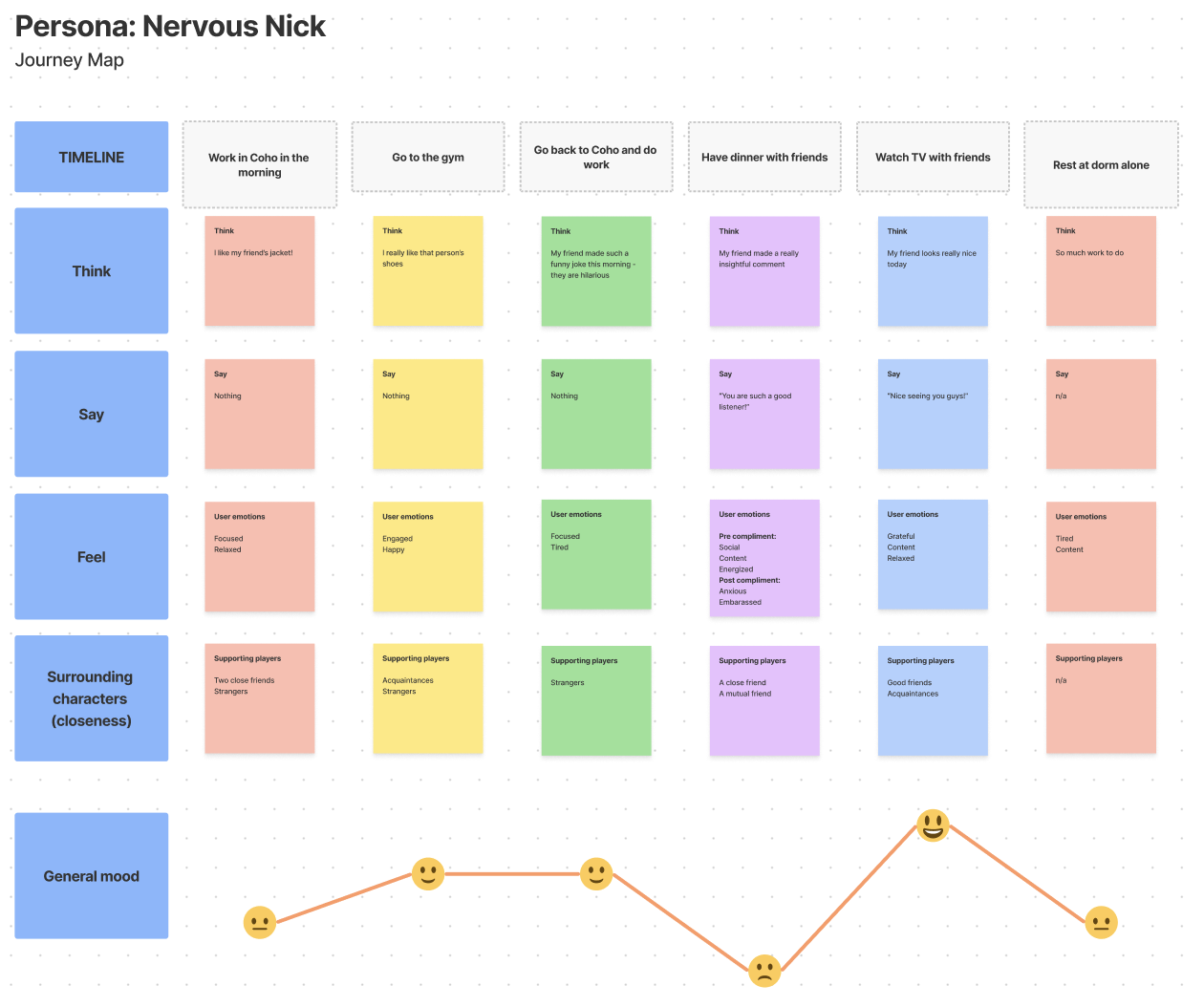
Through doing the journey map for Grateful Grace, we can see that there is a clear divide between what Grace thinks and what she actually ends up saying. She often has meaningful and deep thoughts about her social interactions but instead of vocalizing them, she will give more superficial and surface-level compliments. For Nervous Nick, we can see that he has a harder time activating himself to vocalize his positive thoughts. When he does vocalize positive thoughts, he feels anxious given the spotlight that has been cast on him.
These insights left us wondering if/how we might be able to create a safer space for exchanging compliments, especially deeper compliments. What might it look like for people to give compliments retroactively and/or in a virtual context?
Intervention Study
After synthesizing our baseline findings, our group set out to design an intervention study centered on encouraging people to give more compliments. We brainstormed ideas, discussed the pros and cons of our top three ideas, and finally fleshed out our best idea into a complete intervention study.
Top Three Ideas
Idea 1: Prompt people at the beginning of the day for 1-2 compliments to give during the day. E.g., in the morning, tell users “Look out for someone with a nice smile today, and then tell them!”
- Pros: Encourages positive thoughts throughout the entire day, as participants will be noticing people’s smiles as they interact with others.
- Cons: Participants may fixate on the prompts we give, leading them to give less compliments. This also may discourage more diverse compliments. Lastly, in this idea, we’re only intervening when compliments are given but not received.
Idea 2: Text participants compliments anonymous compliments throughout the day. E.g., “Someone in your French class loved your shirt today!”
- Pros: Controlling the compliments given allows us to curate a diverse set of superficial and deeper, more meaningful compliments. This ensures we will have a good amount of data for different types of compliments.
- Cons: Compliments are developed by us, so they are less authentic. We would have to keep up the illusion that they are coming from people that participants’ know. Lastly, in this idea, we’re only intervening when compliments are received but not given.
Idea 3: Tell participants in a closed group of friends to send compliments to us (about others in the group) throughout the day. Withhold compliments until a designated time, then send out compliments to those who sent in at least one that day. Prompt people to send in compliments before the designated time.
- Pros: Ability to intervene when compliments are given and received. Open-ended prompts allow people to send in a wide variety of compliments. As participants are friends, we may be able to see the delivery of more meaningful compliments. Participants are allowed to send anonymous and non-anonymous compliments.
- Cons: Requires participants to be in the same group of friends, may lead to a less diverse set of participants. Since we’re sending the compliments out at a designated time to encourage participation, that time may still not be appropriate for the deeper compliments being sent out.
We decided that it was most important to study compliments on both ends–given and received. While we want to observe the differences between giving and receiving superficial versus deeper, more meaningful compliments, we want participants to give the latter organically, rather than being explicitly prompted to give certain types of compliments. We believe this model will provide greater insight as to when and why people give certain types of compliments. Given this, we decided to move forward with Idea 3.
Description
We identified 16 individuals who are in the same circle, with hopes that they would see and think about each other throughout the week. 4 were participants in our baseline study. We told all of our participants to send in compliments to one member of our team throughout the day. We did not specify the types of compliments that should be sent in, we just noted that the compliments should be organic: when they think of a compliment, they should send it in. If they see or think about someone in the group but don’t have a specific compliment to give, they do not need to send in a compliment. We will hold compliments until 7pm each day, at which point they will be sent out to recipients. Participants can note if they would like a compliment to be sent anonymously, otherwise, the name of the giver will be sent to the recipient along with the compliment by default. However, only people who have submitted at least one compliment will get to read their compliments. Right before 7pm, participants will be reminded to submit a compliment if they haven’t already if they’d like to see their compliments. Compliments submitted after 7pm will be sent immediately. As greater socialization happens on the weekends for college students, our study is running Tuesday through Saturday.
Data Collection
For each individual, we plan to track the number and types (surface level versus deep) of compliments given and received to discover trends. Do people give more compliments in the days following when they receive a lot of compliments? If someone receives no compliments, does that affect how many they give? Are people more likely to give compliments to those that gave them compliments? Do people send in compliments throughout the day, or only when they’re prompted? Is there a correlation between the type of compliment, and if it’s sent anonymously or not? We are interested in exploring these questions through our intervention study.

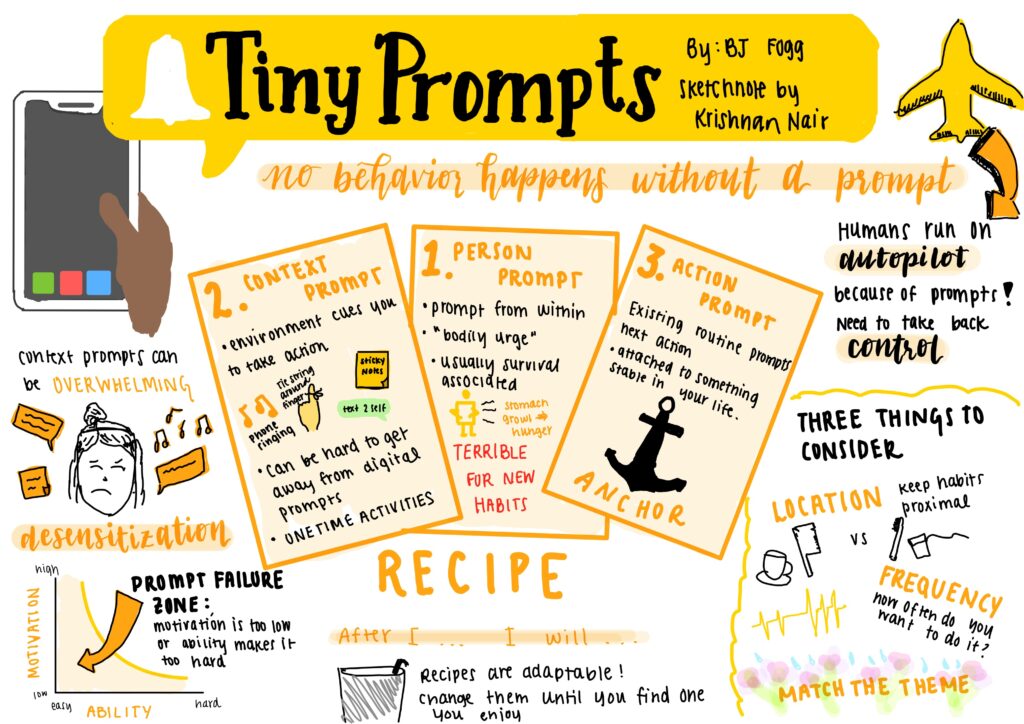

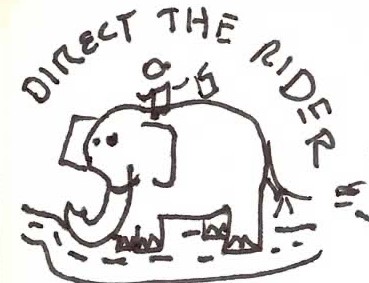
Comments
Comments are closed.